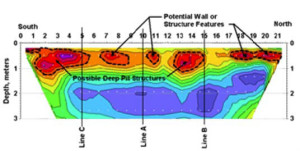Challenge
Mundell was contacted to test the efficacy of combining magnetic methods, 2-D resistivity, and ground penetrating radar (GPR) techniques for pre-evaluating suspected Anasazi ruins, within selected areas of a site, prior to archaeological excavation at a prehistoric complex in Cortez, Colorado. The purpose of this survey was to provide significant insight into the shallow subsurface material characteristics, and also provide valuable aids in guiding excavation activities during a later field school.
Technical Approach
Mundell used Magnetics, 2-D resistivity imaging, and GPR over selected portions of the study area during a three-day study period. Magnetic data were collected with an G&G Geometrics Gradiometer at a 1-meter grid spacing. Vertical and lateral resistivity characteristics of the subsurface materials were determined using a 2-D Advanced Geosciences, Inc. (AGI) Sting R1 portable resistivity imaging system. GPR profiles were acquired using a Sensors & Software Noggin with shielded 250 MHz center-frequency antennas mounted to a Smart Cart with an odometer wheel for accurate positioning. A Noggin Plus digital video logger (DVL) was used to monitor the data in real time. Data were collected at a 0.5-meter line separation along selected lines in areas of interest. Preliminary analysis indicated a strong correlation of the GPR data with the results of the 2-D resistivity plan view maps.
Results
Based on the geophysical survey results, significant archaeological structures were disclosed at a high percentage of anomalous areas exhibiting elevated resistivity and/or magnetic field gradient, or changes in the shallow material properties observed in the ground penetrating radar profile lines. A pueblo with connecting rooms, several deep storage pits, and three burials were identified. Use of multiple geophysical techniques allowed for cross-correlation of anomalous areas, enhancing the likelihood of finding features of significance.



